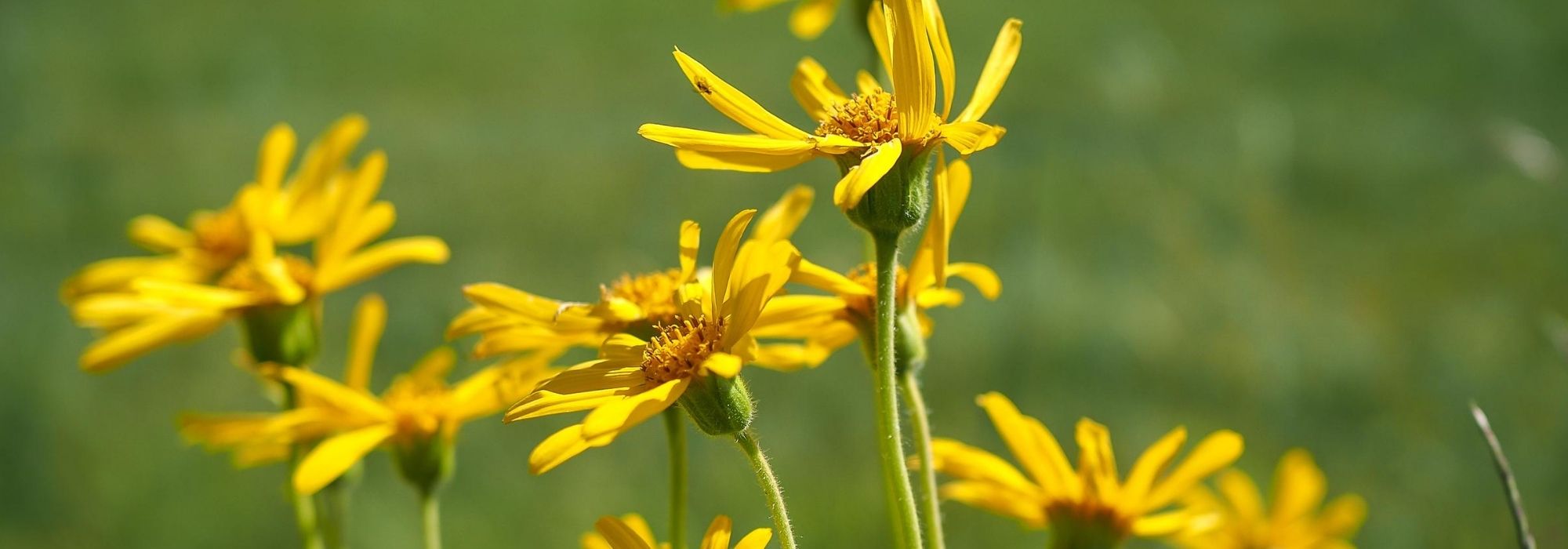
Arnica: sowing, growing, benefits
Contents
Arnica in a nutshell
- Arnica is a medicinal plant known for its anti-inflammatory properties against bruises: it is the bruise plant
- Very floriferous, it offers a profusion of small yellow daisies in summer, renowned for their benefits
- It is essential in homeopathy in ointment, oil, or gel form
- Of rather delicate cultivation, it is, however, very hardy
- With its country-style appearance, it is also an ornamental plant for sunny borders and rockeries
A word from our expert
Arnica is a beautiful asteraceae well-known for its anti-inflammatory properties and its benefits in local applications to relieve bruises and bumps, from which gel, ointment, oil, or even mother tincture are extracted.
Arnica montana, in particular, is a large medicinal perennial plant, widely used in homeopathy: it is also a lovely ornamental plant.
With its yellow daisy-like flowers, it brightens up country gardens, colourful mixed borders, sunny rockeries, as well as squares of culinary and medicinal herbs.
More or less easy to grow, but very hardy, it thrives in light, acid-leaning soils, free from lime and well-drained.
How to successfully cultivate it, when and how to harvest arnica flowers? We will share all the secrets to growing this lovely montane plant!
Description and botany
“`html
Botanical data
- Latin name Arnica
- Family Asteraceae
- Common name Arnica, Leopard's bane, Mountain Tobacco, Alpine Plantain
- Flowering May to August
- Height 0.10 to 0.60 m
- Exposure Sun, Partial shade
- Soil type acidic to neutral, well-drained
- Hardiness -30°C
Arnica is a perennial plant from the Asteraceae family. The genus Arnica comprises about 30 species of perennials native to meadows, alpine pastures, and mountain streams in temperate regions of North America, as well as Asia and Europe.
Alongside the well-known species Arnica montana or mountain arnica, also known as alpine plantain or “herb of falls”, we also find Arnica chamissonis, or American arnica, which is easier to grow and offers better yields than its European cousin.
From a running root, the plant forms an upright, bushy clump, about 50 cm tall and 30 cm wide.
The foliage is deciduous and varies from one species to another. It consists of lanceolate or heart-shaped leaves in A. cordifolia, light to bright green, marked with long prominent veins. They can measure up to 14 cm long and are hairy, even woolly. In Arnica montana, the leaves are arranged in a basal rosette and are characterised by the presence of two small opposite leaves deployed in the middle of each stem.
The foliage of arnica is aromatic: in the past, mountain dwellers smoked it, and it was also called “Mountain Tobacco” or “Savoy Tobacco”.
From May to August, depending on the regions, Arnica produces a profusion of daisy-like flowers, typical of the Asteraceae. The leafy, stiff stems bear terminal inflorescences in solitary heads measuring 3 to 8 cm in diameter, golden yellow sometimes tinged with orange. The ligules spread around a heart of tubular florets forming a more or less flattened pompom.
The nectariferous and fragrant flowers renew continuously, attracting the flight of pollinating insects. They are followed by the formation of seeds that are used in phytotherapy.
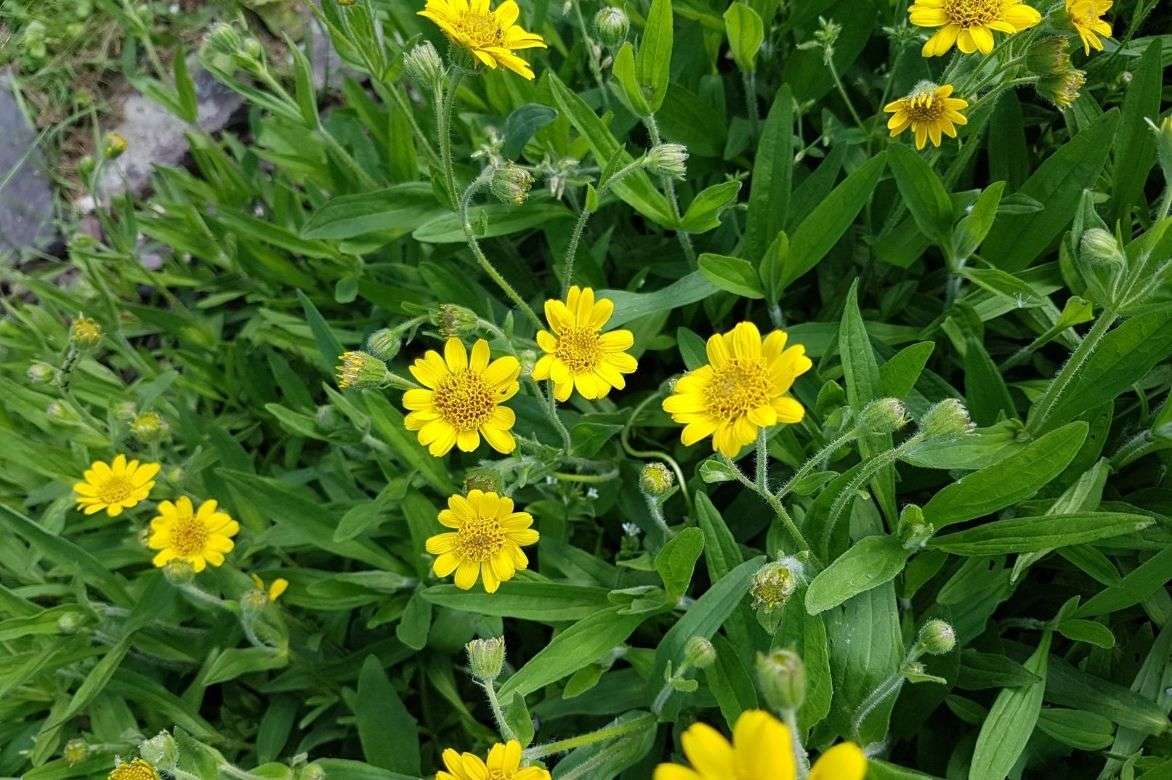
Flowers of Arnica chamissonis
Arnica is both a medicinal and highly ornamental plant. While Arnica montana can still be found spontaneously in France in the Vosges, the Pyrenees, and the Massif Central, its collection is regulated in some of our regions.
“`
Main species and varieties
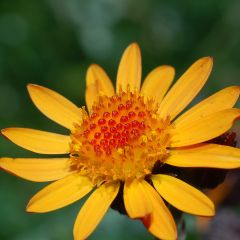
Arnica montana
- Flowering time July, August
- Height at maturity 50 cm
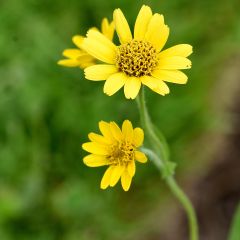
Arnica chamissonis
- Flowering time July, August
- Height at maturity 50 cm
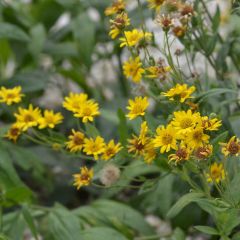
Arnica montana - Ferme de Sainte Marthe seeds
- Flowering time July to October
- Height at maturity 50 cm
Discover other Arnica
View all →Available in 1 sizes
Available in 1 sizes
Available in 1 sizes
Available in 1 sizes
Available in 1 sizes
Planting and sowing
Where to plant and sow Arnica?
Although they are very hardy down to -30 °C and even -45 °C for Arnica chamissonis, their cultivation is quite delicate. Mountain arnica, Arnica montana, is a montane perennial that thrives at high altitudes. It prefers light, acidic soils, free from lime and well-drained. Arnica chamissonis prefers a cool soil that can be occasionally waterlogged.
They require a rather acidic soil type, such as heather soil. They need full sun to flower well and a sheltered position from strong winds that could break the stems. They tolerate partial shade in our warmest regions.
They need about two years to establish well.
Their radiant flowering and bushy appearance make them stand out in all natural gardens, in a country garden or wild setting where they quickly create bucolic scenes. These beautiful wildflowers bring vibrancy and lightness to cottage gardens, mixed borders, or very sunny rockeries.
When to plant Arnica?
Planting should be done in spring, around May-June when temperatures are mild.
How to plant it?
Leave 30 to 35 cm between two plants. Arnica prefers light soils: improve drainage in heavy soils with some coarse sand and potting soil.
- Dig a hole three times the volume of the root ball
- Place the root ball
- Add potting soil and heather soil
- Cover and firm down
- Water frequently to aid establishment, then moderately
When and how to sow?
Sow arnica from February to April for a harvest from May to July the following year as flowering occurs in the second year of cultivation. An autumn sowing is possible: keep your sowings sheltered throughout the winter and transplant your young arnica plants in spring, after the frosts.
- Sow arnica seeds in trays filled with good potting soil mixed with heather soil
- Maintain at around 13°C
- Water to keep the substrate moist but not waterlogged until germination
- Transplant the young seedlings into individual pots
- Keep the soil moist
- Plant in the garden the following spring
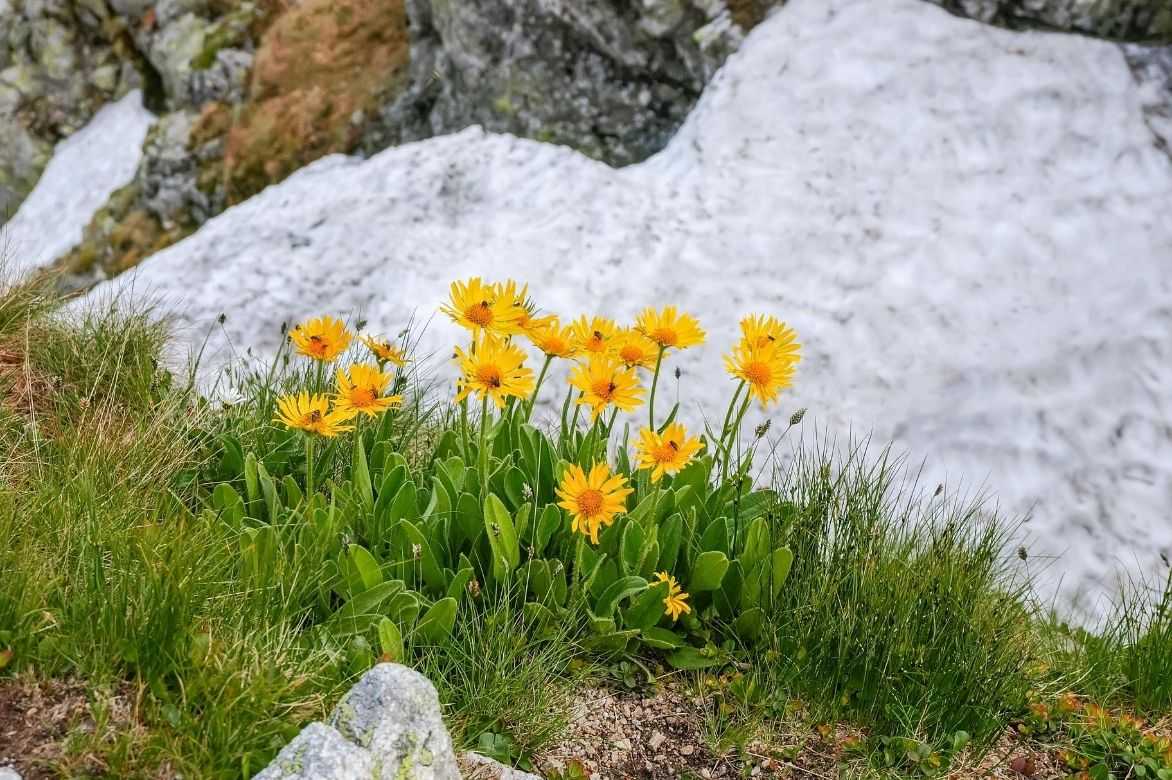
Beautiful clump of Arnica montana
Read also
10 perennials to grow in acidic soilMaintenance and care
Once established in soil that meets the requirements of the Arnica, it requires little care.
During the first spring and summer, water regularly but without flooding: the plant should remain moist. Afterwards, water moderately, except during prolonged summer droughts.
After flowering, when the foliage is wilted, lightly trim the stems.
When and how to harvest arnica flowers?
Harvest: harvest the arnica flowers in the morning, simply by hand, at the start of their flowering before they fully open. Spread the flowers on a rack or mesh in a very dry, warm, and shaded area.
Storage: once dry, place the flowers in jars or airtight boxes to preserve all their medicinal qualities.
Benefits and uses of Arnica
Arnica has been used since the Middle Ages for its medicinal properties. The flowers and roots of Arnicas (A. montana and A. Chamissonis), rich in essential oils, are widely used in phytotherapy as well as in homeopathy for their anti-inflammatory and anti-neuralgic properties. It is traditionally used to soothe muscle and joint pain, to treat bruises, bumps, insect bites, knocks, and contusions. Arnica is primarily used externally in the form of tincture, decoction, ointment, oil, gel, or granules.
Diseases and potential pests
At the end of summer, Arnica can be susceptible to powdery mildew, which is noticeable by the appearance of a white fluff on the leaves. As a preventive measure: water at the base without wetting the leaves and spray with horsetail or nettle manure. And follow our advice in our dedicated sheet on white disease.
Humidity can also lead to rust: generally avoid wetting the leaves and as a preventive measure, spray with Bordeaux mixture.
Defoliating caterpillars sometimes attack: remove the caterpillars and webs on the plant, prune the affected stems, and spray with a mixture containing pyrethrum.
It is wise to protect the foliage from the appetites of slugs and snails: use fern manure to combat their attacks and take inspiration from our 7 ways to fight slugs effectively and naturally and how to make a slug trap.
In case of excess lime in the soil, the plant risks developing chlorosis: avoid watering with hard water.
Multiplication
Arnica multiplies rapidly by division of stump in April or autumn. To do this, choose a healthy and mature plant that is at least 4 or 5 years old, divide it using a sharp knife, and then replant the removed sections.
Associating
With its radiant flowering, Arnica is also cultivated for its ornamental interest. It will be useful for creating very sunny summer scenes.
In natural and countryside gardens, it will bring lightness and colour.
In a border or mixed border in full sun, Arnica flowers will cheerfully blend with other summer-flowering perennials such as echinaceas, yarrow, asters, and Coreopsis.
Arnica will find its place at the heart of a flowering vegetable garden where it will be very useful to pair it with edible flowers like Nasturtium, marigold, or alongside other medicinal plants such as Chamomile or Calendula officinalis, common sage, and with aromatic herbs like lavender, variegated mint, fennel, or golden lemon thyme.
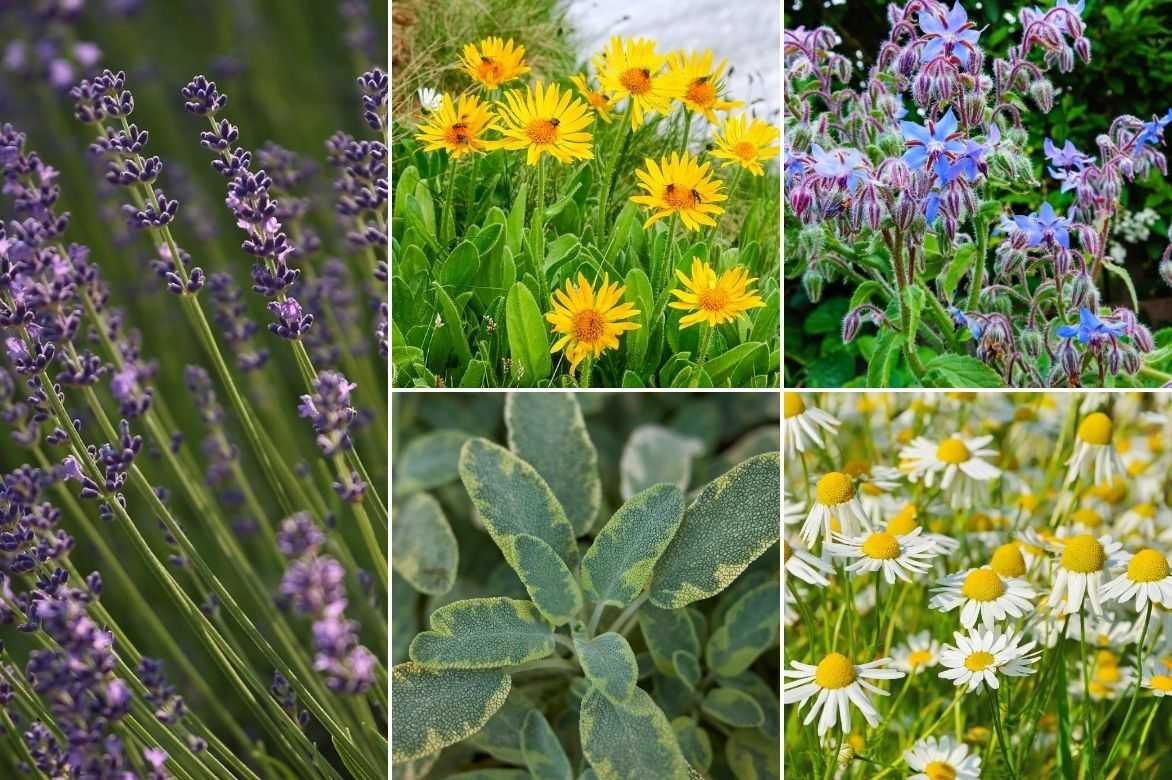
An idea for pairing in an edible, aromatic, or medicinal garden: Arnica montana, True Lavender, Sage ‘Icterina’ (=’Aurea’), Borage, and Chamomile (Matricaria recutita)
Useful resources
- Discover our selection of 15 medicinal plants with numerous benefits… to grow in your garden!
- To accompany your arnica, choose from our beautiful collection of daisy-type annuals.
- Subscribe!
- Contents
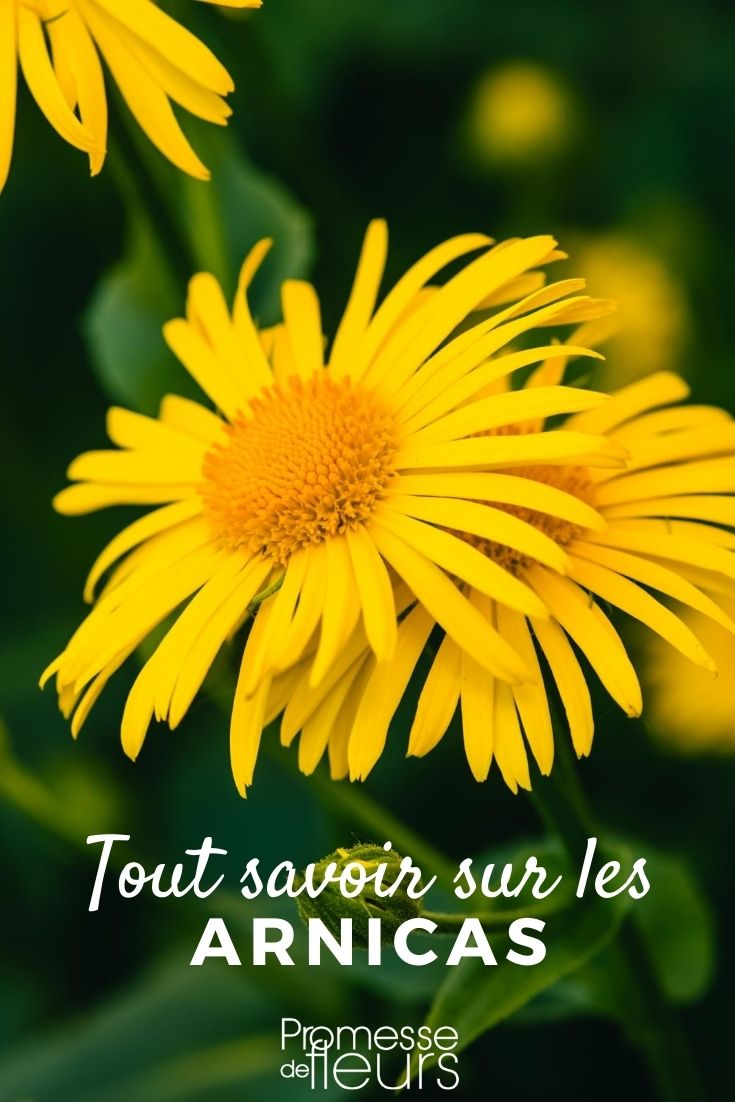


































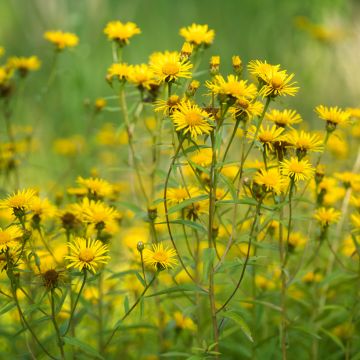
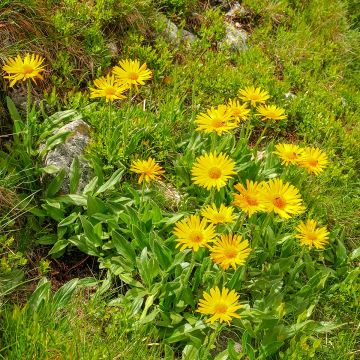
Comments